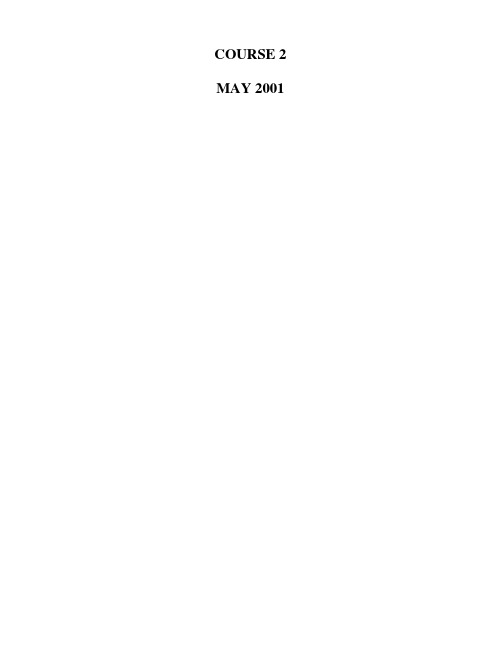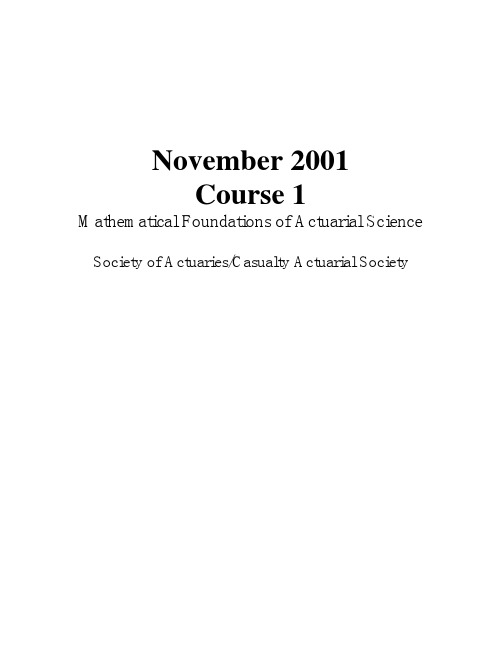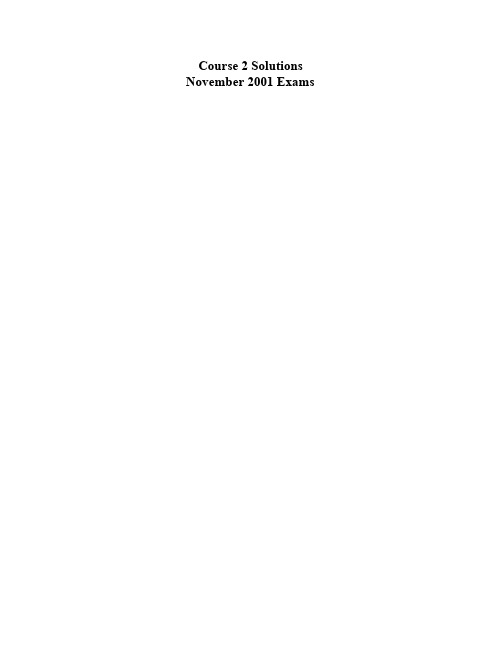北美精算师(SOA)考试P 2000年 May 真题
北美精算师真题course1

Calculate the percentage of the group that watched none of the three sports during the last year.
(A) (B) (C) (D) (E)
24 36 41 52 60
Course 1
6
Form 03A
2.
c f ( x ) − dg ( x ) . x →0 f ( x ) − g ( x )
(A) (B) (C) (D) (E)
0 cf ′ ( 0 ) − dg ′ ( 0 ) f ′ ( 0) − g′ ( 0)
f ′ ( 0) − g′ ( 0) c−d c+d
Course 1
8
Form 03A
(A) (B) (C) (D) (E)
0.07 0.29 0.38 0.42 0.57
May 2003
9
Course 1
5.
An insurance company examines its pool of auto insurance customers and gathers the following information:
Each of the graphs below contains two curves.
Identify the graph containing a curve representing a function y = f ( x ) and a curve representing its second derivative y = f ′′ ( x ) .
Calculate the rate at which the value of the investment is changing after 8 years.
北美精算师(SOA)考试 FM 2001 May 年真题

1.
Which of the following statements is an implication of the semi-strong form of the Efficient Market Hypothesis?
(A) (B) (C) (D) (E)
Course 2
12
Form 01A
9.
Which of the following statements regarding consumer goods in the marketplace is true?
(A) (B) (C) (D) (E)
The quantity demanded of an inferior good decreases as its price decreases. The intersection of a consumer’s Engel curve and demand curve represents how much the consumer will buy given a specific income level. When the price of a normal good decreases, the increase in quantity due to the income effect cannot be greater than the substitution effect. The compensated demand curve for a normal good will be steeper than the uncompensated demand curve. The income elasticity of demand is equal to the slope of the Engel curve.
2000年真题与解析

2000年真题与解析If a farmer wishes to succeed, he must try to keep a wide gap between his consumption and his production. He must store a large quantity of grain 1 consuming all his grain immediately. He can continue to support himself and his family 2 he produces a surplus. He must use this surplus in three ways: as seed for sowing, as an insurance 3 the unpredictable effects of bad weather and as a commodity which he must sell in order to 4 old agricultural implements and obtain chemical fertilizers to 5 the soil. He may also need money to construct irrigation 6 and improve his farm in other ways. If no surplus is available, a farmer cannot be 7 . He must either sell some of his property or 8 extra funds in the form of loans. Naturally he will try to borrow money at a low 9 of interest, but loans of this kind are not 10 obtainable.1. [A] other than [B] as well as [C] instead of [D] more than2. [A] only if [B] much as [C] long before [D] ever since3. [A] for [B] against [C] of [D] towards4. [A] replace [B] purchase [C] supplement [D] dispose5. [A] enhance [B] mix [C] feed [D] raise6. [A] vessels [B] routes [C] paths [D] channels7. [A] self-confident [B] self-sufficient [C] self-satisfied [D] self-restrained8. [A] search [B] save [C] offer [D] seek9. [A] proportion [B] percentage [C] rate [D] ratio10. [A] genuinely [B] obviously [C] presumably [D] frequently试题解析1. 【答案解析】C考查知识点: 逻辑关系+短语辨析文章的第一句点明了全文的主题:如果一个农民想成功,他必须保证生产远远大于其消费。
北美精算师(SOA)考试P 2000 November年真题

(A) (B) (C) (D) (E)
208 260 270 312 374
November 2000
1
Course 1
2.
An investor purchases two assets, each having an initial value of 1000 . The value Vn of the first asset after n years can be modeled by the relationship:
0.06 0.16 0.19 0.22 0.25
Course 1
12
Form 00B
13.
An actuary believes that the demand for life insurance, L, and the demand for health insurance, H, can be modeled as functions of time, t:
What is the approximate probability that there is a total of between 2450 and 2600 claims during a one-year period?
(A) (B) (C) (D) (E)
0.68 0.82 0.87 0.95 1.00
Course 1
2
Form 00B
3.
An auto insurance company has 10,000 policyholders. Each policyholder is classified as
(i) (ii) (iii)
young or old; male or female; and married or single.
北美精算学会-SOA-考试制度第2页-精算师考试.doc

财务课程编号名称学分p385财务管理20f580公司财务15f585应用公司财务20f590公司战略和偿付能力管理10团体和健康保险课程编号名称学分g320团体和个人健康保险30的设计和销售g421团体和个人健康保险25的财务管理和法规g422团体和个人健康保险25的定价g522高级品种10g523非养老年金的退休后10和就业前的福利g525灵活的福利计划10g528健康保险专题15个人人寿和年金保险课程编号名称学分l340个人人寿和年金保险30的精算实务调查l343 人寿保险法和税收15n41高级设计和定价25n43估价和财务报告专题25l540个人人寿和年金保险10的营销l545丧失工作能力收入15l550再保险专题15养老金课程编号名称学分p360养老金估价原理15p362退休计划设计15p363养老金筹资工具15p365养老金计划的法律规定25p461养老金估价原理ii和20养老金计划会计标准p560 国际养老金问题20p564作为专家证人的10p567退休收入保障25投资课程编号名称学分v480衍生证券:理论和应用20v485高级资产组合管理15v595资产和负伤管理应用20要取得fsa资格必须通过以上一个方向的所有课程考试,以及再选择以上方向的其他课程,使学分达到150分,即学分总计要达到450分。
此外,当fsa要素的课程考试全部通过后,考生还要参加最后一门课程一一正认可课程(fac),其内容主要是职业道德和案例,时间为二天半,一般只要自始自终参加,在结束后的晚宴上会获得fsa证书。
到1996年,北美精算学会共有会员16,558名,其中美国11,961名,加拿大3,161名,其他国家1,436名,(除了fsa、asa外,还包括少量的财产和意外险和美国养老金)20,592人,其中美国15,695人,加拿大3,355人,其他国家1,542人。
北美精算学会的考点分布在全世界28个国家和地区,考试每年在春季(五月)和秋季(十一月)举行两次,全世界每年有数干人参加asa一万多门次课程的考试,其中asa的平均通过率为40%。
北美精算师(SOA)考试P 2001 November年真题

is independent of the number of accidents that occur in all other months.
Calculate the probability that there will be at least four months in which no accidents occur before the fourth month in which at least one accident occurs.
(A) (B) (C) (D) (E)
0.0000 0.0004 0.0027 0.0064 0.3679
Course 1, November 2001
9
9.
Among a large group of patients recovering from shoulder injuries, it is found that 22% visit both a physical therapist and a chiropractor, whereas 12% visit neither of these. The probability that a patient visits a chiropractor exceeds by 0.14 the probability that a patient visits a physical therapist.
(–1)n n
− an = 1 2n n
Course 1, November 2001
11
11.
A company takes out an insurance policy to cover accidents that occur at its manufacturing plant. The probability that one or more accidents will occur during any given month is
北美精算师考试大纲 2012-May-exam-p

Probability ExamThe Probability Exam is called Exam P by the SOA and Exam 1 by the CAS. This three-hour exam consists of 30 multiple-choice questions. The examination is jointly sponsored and administered by the SOA, CAS, and the Canadian Institute of Actuaries (CIA). The examination is also jointly sponsored by the American Academy of Actuaries (AAA) and the Conference of Consulting Actuaries (CCA).The Probability Exam is administered as a computer-based test. For additional details, Please refer to Exam Rules.The purpose of the syllabus for this examination is to develop knowledge of the fundamental probability tools for quantitatively assessing risk. The application of these tools to problems encountered in actuarial science is emphasized. A thorough command of the supporting calculus is assumed. Additionally, a very basic knowledge of insurance and risk management is assumed.A table of values for the normal distribution is available below for candidates to download and will be included with the examination. Since the table will be included with the examination, candidates will not be allowed to bring copies of the table into the examination room.Check the Updates section on this exam’s home page for any changes to the exam or syllabus.The ranges of weights shown are intended to apply to the large majority of exams administered. On occasion, the weights of topics on an individual exam may fall outside the published range. Candidates should also recognize that some questions may cover multiple learning outcomes.Each multiple-choice problem includes five answer choices identified by the letters A, B, C, D, and E, only one of which is correct. Candidates must indicate responses to each question on the computer.As part of the computer-based testing process, a few pilot questions will be randomly placed in the exam (paper and pencil and computer-based forms). These pilot questions are included to judge their effectiveness for future exams, but they will not be used in the scoring of this exam. All other questions will be considered in the scoring. All unanswered questions are scored incorrect. Therefore, candidates should answer every question on the exam. There is no set requirement for the distribution of correct answers for the SOA/CAS/CIA multiple-choice preliminary examinations. It is possible that a particular answer choice could appear many times on an examination or not at all. Candidates are advised to answer each question to the best of their ability, independently from how they have answered other questions on the examination.Since the CBT exam will be offered over a period of a few days, each candidate will receive a test form composed of questions selected from a pool of questions. Statistical scaling methods are used to ensure within reasonable and practical limits that, during the same testing period of a few days, all forms of thetest are comparable in content and passing criteria. The methodology that has been adopted is used by many credentialing programs that give multiple forms of an exam.LEARNING OUTCOMESCandidates should be able to use and apply the following concepts in a risk management context:1. General Probability (15-30%)•Set functions including set notation and basic elements of probability•Mutually exclusive events•Addition and multiplication rules•Independence of events•Combinatorial probability•Conditional probability•Bayes Theorem / Law of total probability2. Univariate probability distributions (including binomial, negative binomial, geometric,hypergeometric, Poisson, uniform, exponential, gamma, and normal) (30-50%)•Probability functions and probability density functions•Cumulative distribution functions•Mode, median, percentiles, and moments•Variance and measures of dispersion•Moment generating functions•Transformations3. Multivariate probability distributions (including the bivariate normal) (30-45%)•Joint probability functions and joint probability density functions•Joint cumulative distribution functions•Central Limit Theorem•Conditional and marginal probability distributions•Moments for joint, conditional, and marginal probability distributions•Joint moment generating functions•Variance and measures of dispersion for conditional and marginal probability distributions•Covariance and correlation coefficients•Transformations and order statistics•Probabilities and moments for linear combinations of independent random variablesREFERENCESSuggested TextsThere is no single required text for this exam. The texts listed below may be considered as representative of the many texts available to cover material on which the candidate may be examined. Texts are added and deleted as part of a regular process to keep the list up-to-date. The addition or deletion of a textbook does not change the bank of questions available for examinations. There is no advantage to selecting a text recently added or not using a text recently removed.Not all the topics may be covered adequately by just one text. Candidates may wish to use more than one of the following or other texts of their choosing in their preparation. Earlier or later editions may also be adequate for review.• A First Course in Probability (Eighth Edition), 2009, by Ross, S.M., Chapters 1–8.•Mathematical Statistics with Applications (Seventh Edition), 2008, by Wackerly, D., Mendenhall III, W., Scheaffer, R., Chapters 1-7.•Probability for Risk Management, (Second Edition), 2006, by Hassett, M. and Stewart,D., Chapters 1–11.• Probability and Statistical Inference (Eighth Edition), 2009, by Hogg, R.V. and Tanis,E.A., Chapters 1–5.•Probability and Statistics with Applications: A Problem Solving Text, 2010, by Asimow, L. and Maxwell, M.•Probability: The Science of Uncertainty with Applications to Investments, Insurance and Engineering 2009, by Bean, M.A., Chapters 1–9.Other ResourcesThe candidate is expected to be familiar with the concepts introduced in “Risk and Insurance”.Tables for Exam P/1Exam P/1 Sample Questions and Solutions (1–153)Risk and Insurance。
北美精算师(SOA)考试 FM 2001 November 年真题和注解

25.
E In order to solve for the price of a call option, first the price of a put option must be determined and then the put-call parity formula is used. Price of put option: [(0.5 x 0) + (0.5 x 10)] / 1.04 = 5/1.04 = 4.81 Price of call option = Price of put option + current stock price – present value of exercise price Price of call option = 4.81 + 45 – 40/1.04 = 11.35
Course 2 Solutions
1
November 2001
5.
A ¬9.2 + 10 ⋅V Present value = 10 ⋅ a5
1+ k 20 = 0.092 − k 0.84 = 21k k = 0.04
5 9.2
(1 + k ) ( 6.44 )(1 + k ) ∑ (1.092) = 38.70 + 0.092 − k = 167.50 t =1
3.
B
∆Y ∆N ∆K − (α N ) − (1 − α N ) = 2.6 − (0.7)(2.0) − (1 − 0.7)(4.0) = 2.6 − 1.4 − 1.2 = 0.0 Y N K
4.
C APV = Base-case NPV + PV tax shield 120, 000 0.35 × 0.08 × 0.54(100, 000) = −100, 000 + + = 0 + 1,400 = 1,400 . 1.2 1.08
- 1、下载文档前请自行甄别文档内容的完整性,平台不提供额外的编辑、内容补充、找答案等附加服务。
- 2、"仅部分预览"的文档,不可在线预览部分如存在完整性等问题,可反馈申请退款(可完整预览的文档不适用该条件!)。
- 3、如文档侵犯您的权益,请联系客服反馈,我们会尽快为您处理(人工客服工作时间:9:00-18:30)。
Determine the probability that the model year of this automobile is 1997 .
(A) (B) (C) (D) (E)
0.22 0.30 0.33 0.45 0.50
Course 1
4
May 2000
3.
The lifetime of a printer costing 200 is exponentially distributed with mean 2 years.
I
Course 1
2
1.
The probability that a visit to a primary care physician’s (PCP) office results in neither lab work nor referral to a specialist is 35% . Of those coming to a PCP’s office, 30% are referred to specialists and 40% require lab work.
4. Answer sheets are mechanically scored. BE SURE THAT EACH MARK IS BLACK AND COMPLETELY FILLS ONLY THE INTENDED ANSWER CIRCLE. Make no stray marks on the answer sheet. Choose only one answer for each question. If you change an answer, erase your first mark completely and mark your new choice. 5. Use the blank portions of booklet pages for your scratch work. You are not permitted to use extra scratch paper. 6. In questions involving money, no monetary unit is specified, and nothing is implied by the magnitude of the numbers. 7. Do not spend too much time on any question. If a question seems too difficult, go on to the next question. You may return to unanswered questions if you finish before time is called. 8. Your score will be based on the number of questions that you answer correctly, with each question having equal weight. There will be no deduction for wrong answers. It is therefore to your advantage to answer every question. 9. After time is called, the supervisor will collect the booklet and your answer sheet separately. DO NOT ENCLOSE THE ANSWER SHEET IN THE BOOKLET. All booklets and answer sheets must be returned. THE QUESTIONS ARE CONFIDENTIAL AND MAY NOT BE TAKEN FROM THE EXAMINATION ROOM. ©2000 by the Society of Actuaries and the Casualty Actuarial Society. All rights reserved. Society of Actuaries 475 N. Martingale Road, Suite 800 Schaumburg, IL 60173-2226
Determine the probability that a visit to a PCP’s office results in both lab work and referral to a specialist.
(A) (B) (C) (D) (E)
0.05 0.12 0.18 0.25 0.35
Example Calculate the value of x in the equation x + 6 = –3 . (A) (B) (C) (D) (E) –9 –3 –2 3 9
Sample Answer
GENERAL INFORMATION
1. 2. 3. ln x is the natural logarithm of x .
May 2000
3
Course 1
2.
A study of automobile accidents produced the following data:
Model year 1997 1998 1999 Other
Proportion of all vehicles 0.16 0.18 0.20 0.46
The manufacturer agrees to pay a full refund to a buyer if the printer fails during the first year following its purchase, and a one-half refund if it fails during the second year.
R n is n-dimensional Euclidean space.
2 X E( X ) denotes the mean of a random variable X .
82 X Var ( X ) denotes the variance of X .
8 XY Cov( X , Y ) denotes the covariance of two random variables X and Y . 7 XY Corr ( X , Y ) denotes the correlation coefficient of X and Y .
n
X 4.
¦ Xi
i 1
n
denotes the mean of a sample X1,..., Xn .
The Normal Distribution
1 x w2 / 2 e dw for certain values 25 f of x . The integer part of x is given in the top row, and the first decimal place of x is given in the left column. Since the density function of x is symmetric, the value of the cumulative distribution function for negative x can be obtained by subtracting from unity the value of the cumulative distribution function for x . The table below gives the value of )( x ) x 0.0 0.1 0.2 0.3 0.4 0.5 0.6 0.7 0.8 0.9 0 0.5000 0.5398 0.5793 0.6179 0.6554 0.6915 0.7257 0.7580 0.7881 0.8159 1 0.8413 0.8643 0.8849 0.9032 0.9192 0.9332 0.9452 0.9554 0.9641 0.9713 2 0.9772 0.9821 0.9861 0.9893 0.9918 0.9938 0.9953 0.9965 0.9974 0.9981 3 0.9987 0.9990 0.9993 0.9995 0.9997 0.9998 0.9998 0.9999 0.9999 1.0000 Selected Points of the Normal Distribution x (x) 0.800 0.842 0.850 1.036 0.900 1.282 0.950 1.645 0.975 1.960 0.990 2.326 0.995 2.576 May 2000
Mathematical Foundations of Actuarial Science SOCIETY OF ACTUARIES
1
Wednesday, May 24, 2000 DIRECTIONS
CASUALTY ACTUARIAL SOCIETY
1. DO NOT BREAK THE SEAL OF THE BOOKLET UNTIL THE SUPERVISOR TELLS YOU TO DO SO. 2. This test consists of 40 multiple-choice test questions. You will have a total of 180 minutes in which to answer them and record your answers on the answer sheet. NO ADDITIONAL TIME WILL BE ALLOWED FOR CODING YOUR ANSWER SHEET. Failure to stop writing or coding your answer sheet after time is called will result in the disqualification of your answer sheet and possible further disciplinary action. 3. There are five answer choices for each question, lettered (A) through (E). Answer choices for some questions have been rounded. For each question, choose the best answer. On your answer sheet, find the row of circles with the same number as the question. Then find the circle in that row with the same letter as your answer. Use a soft lead pencil and blacken the circle completely. INDICATE ALL YOUR ANSWERS ON THE ANSWER SHEET. No credit will be given for anything written in the booklet.
